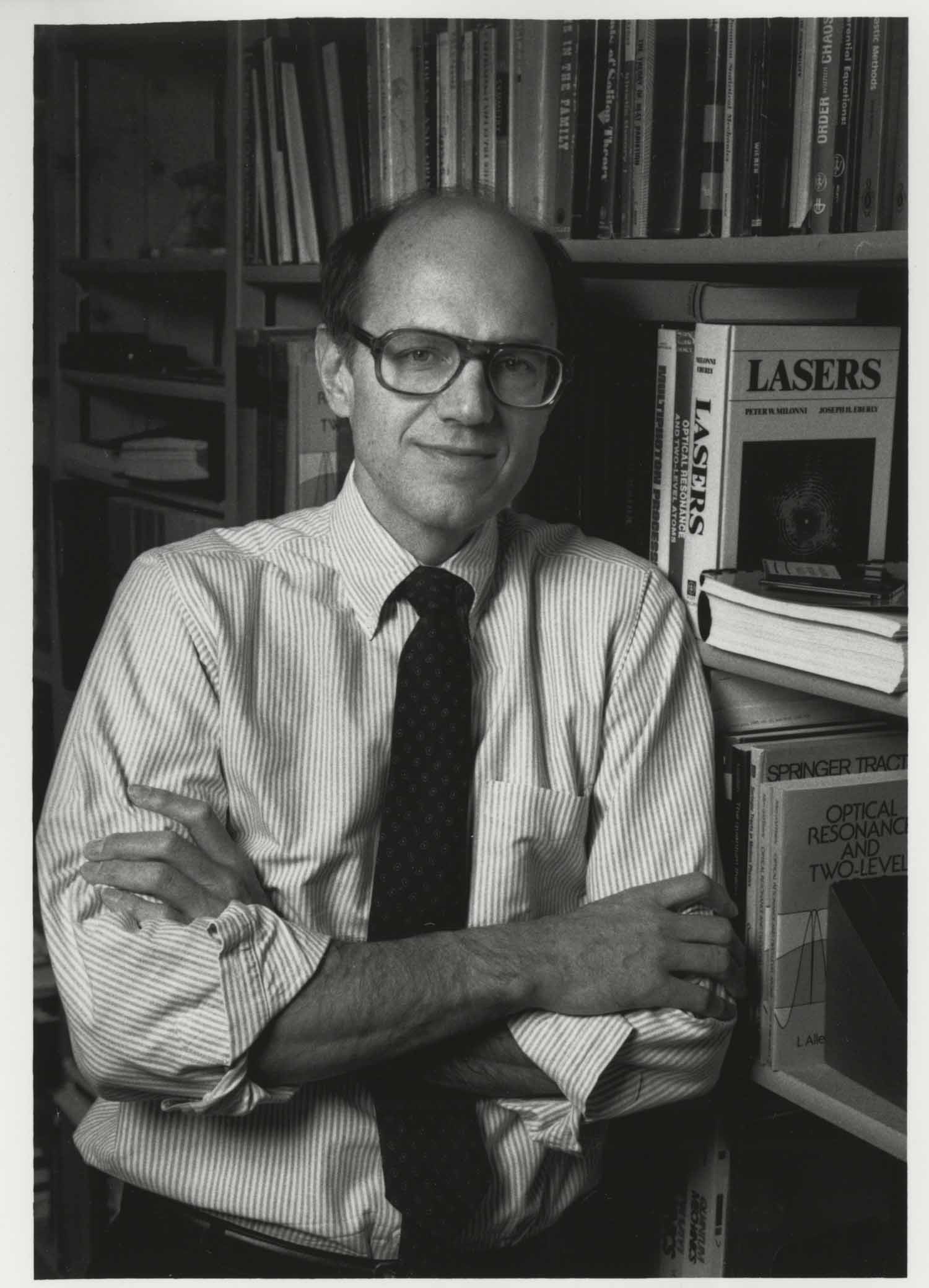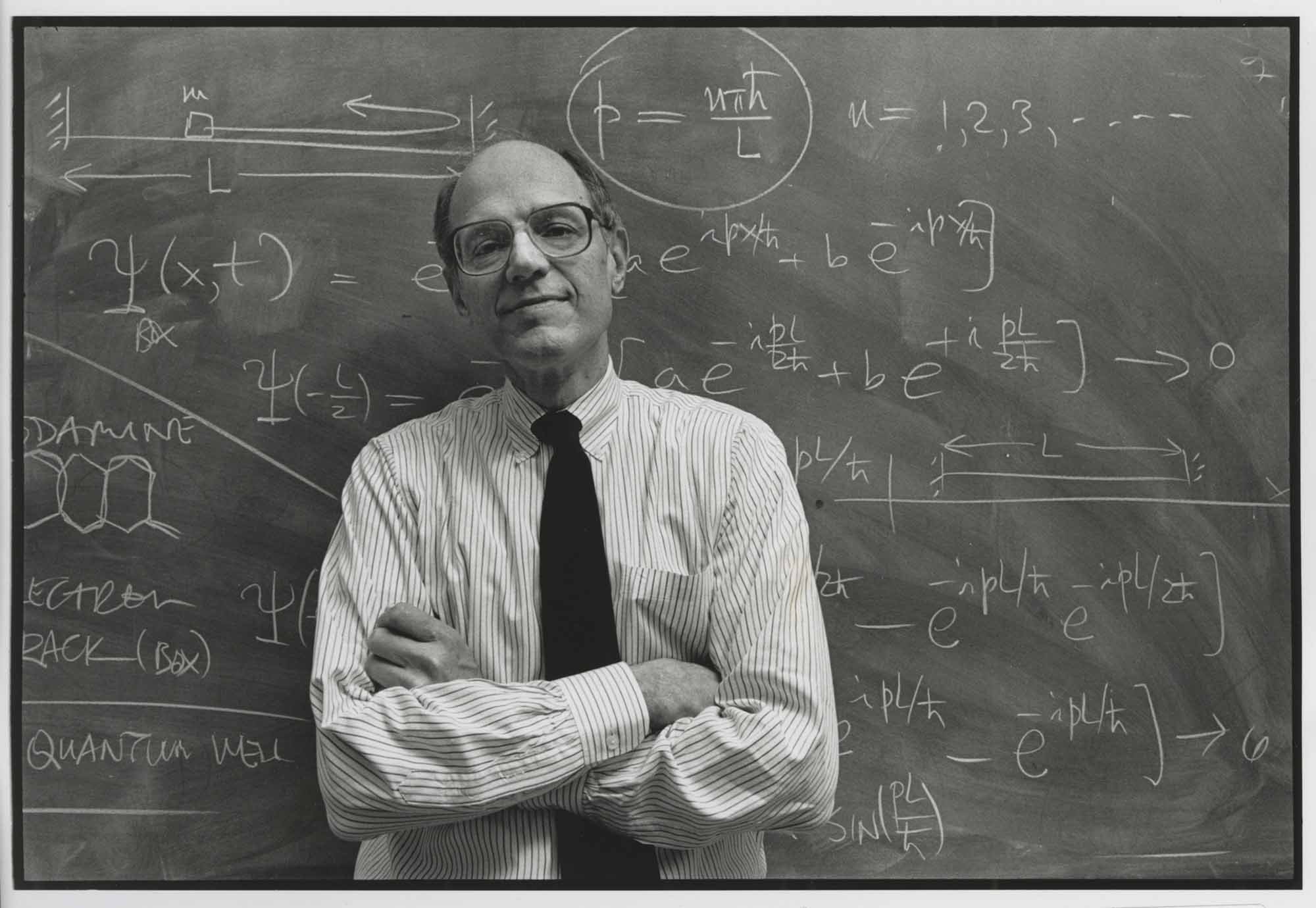His serendipitous original foray into optics research would help advance the fields of quantum optics and optical physics.

It wasn't just his six-foot, four-inch height that made Joseph Eberly, the Andrew Carnegie Professor of Physics and a professor of optics at the University of Rochester, stand out. Eberly, who died this past week at the age of 89, was a pioneering theorist in quantum optics whose ideas reshaped the field.
"Whether it was his seminal books and papers on lasers and quantum optics, his role as the founding editor in chief and architect of Optics Express, his memorable moments as an instructor, or simply the camaraderie that he brought to his scientific and leadership circles, Joe left an indelible mark on all he did," says Thomas Brown, the director of the University's Institute of Optics, calling him "a giant in the optics community."
During his prolific career, Eberly published more than 400 scientific journal articles. He also coauthored three monographs and textbooks on lasers and quantum optics and cofounded three international conferences for quantum optical physics.
Eberly's most notable contributions to his field include the initial description of the spontaneous collapse and revival effect of coherence in the dynamics of a simple quantum model, the first description of Bessel beams, predictions of the recently observed non-spreading localized states of electrons in atoms, and the sudden death effect in quantum entanglement.
The winner of numerous awards and accolades, he served as president of Optica, the international society for optics and photonics, and in 2021 was selected as an Optica Honorary Member, its most distinguished member category. The society's recent tribute to Eberly specifically highlights his research and leadership in advancing optics and photonics worldwide. He was also a fellow of the American Physical Society and chair of its Division of Laser Science.
'Optics by accident'

Eberly's career start in optics was serendipitous.
"I got into optics by accident," Eberly told the Optical Society of America (now Optica) in 2016. "I had done a theoretical PhD thesis and it didn't have anything directly to do with optics at all."
After he earned a doctorate in physics from Stanford University in 1962, Eberly landed a research position at the Naval Ordnance Laboratory in Maryland. Upon his arrival, the division director asked him about lasers. "It seems a little bit silly now, but I didn't know anything really about lasers," Eberly said. "Except that I knew that the guy who was asking the question really wanted to know how was he going to use lasers to shoot down submarines."
Recalling that moment, Eberly audibly chuckled on camera before nixing the whole idea as "completely crazy," explaining that there's no wavelength that can work satisfactorily in conductive media like saltwater. Nevertheless, the lab proved his first "little bit of a push in the direction of optics," which he followed up by coming to Rochester to work with Emil Wolf, whom Eberly called a "world guru in optics at that time."
The faculty triumvirate of Wolf, Eberly, and Leonard Mandel effectively started the field of quantum optics at the University of Rochester. "They were world leaders in that," according Eberly's close friend and Rochester colleague, Carlos Stroud, a professor emeritus of optics and physics and a historian of optics. Stroud is confident that, besides his scientific acumen, Eberly will be remembered for his strong mentorship.
"All who worked with him will state unequivocally that he had a huge influence on their lives, particularly the scientific part of it, and was crucial in the development of their careers," says Stroud. "I could name 50 people who would say that, and that's not just Americans."
A notable example of Eberly's influence? His work on the ionization of atoms by extremely strong laser pulses was used by then-graduate student Donna Strickland to satisfy a Rochester dean's requirement in the late 1980s that a thesis could not be based on an invention, but instead its use had to answer an intellectual question, recalls Stroud.
She did just fine with Eberly's model: Nearly three decades later, Strickland, now a professor at the University of Waterloo in Ontario, Canada, and her former graduate advisor, Gérard Mourou, won the 2018 Nobel Prize in Physics for the work they undertook at the University's Laboratory for Laser Energetics (LLE).
A teaching career spanning five decades
Stroud and Eberly, who as graduate students had shared the same thesis advisor before arriving on campus, jointly taught an introductory graduate course in quantum optics over the course of the half-century that they were both on the Rochester faculty.
"We had great fun with it," remembers Stroud. "It was a privilege to share the lectures. He listened to mine, and I listened to his." In recognition of his teaching excellence, the University awarded Eberly the Goergen Award for Distinguished Achievement and Artistry in Undergraduate Teaching in 2000.

And Eberly never stopped. Having joined the Rochester physics and astronomy faculty in 1965, he was still teaching an undergraduate class this spring semester-PHYS 143: 20th-Century Physics-when he took ill a few weeks ago.
"He gave wonderful lectures," says Stroud. But he could also be intimidating, his long-time friend allows. "Not just to undergraduates but also to colleagues." According to Stroud, Eberly held strong opinions and expressed them freely.
Part of his success lay in his intense competitiveness that extended beyond his academic pursuits. In his younger years, the lanky Eberly would play basketball at lunchtime once a week with a group on campus that also included a Rochester basketball coach. To Eberly this was more than a friendly game of pickup. "He was known for his elbows," chuckles Stroud.
In an email to faculty, Steven Manly, a professor of physics and the chair of the Department of Physics and Astronomy, called colleague and friend Eberly a "spectacular" scientist. "The hole he is leaving behind in our world feels very big to me."






